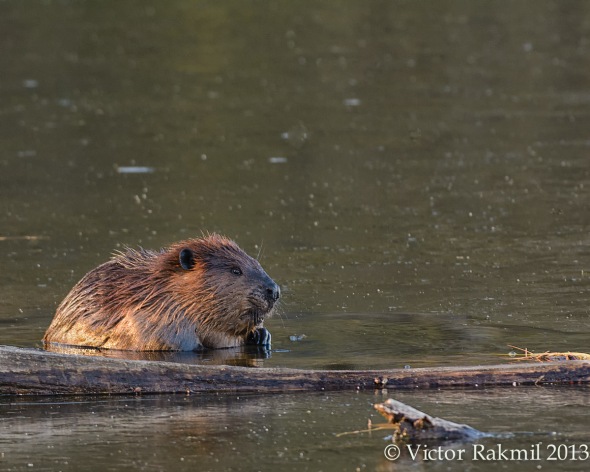Beavers (and a note about creative white balance)
 To view more please click on: Beavers
To view more please click on: Beavers
Watching a beaver crawl out of the water with mud tucked under its chin and climb on its hind legs the height of it lodge to patch the roof; turning around and doing it over and over again, brings true meaning to busy as a beaver. We stood and watched one beaver do this about 20 times without a break and was still going when we left.
The photograph above is one of a series on my SmugMug Blog.
The photographic problems in these circumstances are numerous. I was shooting for the most part in increasingly low light, where flash would only reach so far. In addition the beaver’s coloring is similar to some of the undergrowth. They are in almost constant motion, eating, working, and swimming. They are also a significant distance away for the most part. One did pop out of the ice by my feet, too close for a shot and in any event when we noticed each other he went the other way underwater. It’s tempting given the low probability of getting good shots to just watch the show.
Creative white balance: The auto-white balance in your camera works most of the time, when it does not there are three solutions: go to the manual settings for white balance, do a manual preset if you have the gear, and fix it in post. Auto White balance works for me most of the time and I seldom change it in camera. I am shooting with Nikon’s neutral color settings so my photographs look a bit flat out of the camera. I check my white balance with the available tools in post-processing to ensure my colors are correct.
I also apply creative white balance when needed. For example, in the photograph above the white balance was slightly warmed. In the days of film we had warming and cooling filters. I had a whole bunch of the Nikon 81a warming filters they made people’s skin look better and just about everything else. These filters were around since the days of black and white and were repurposed for color film. In short, creative white balance has been around for a long time but now it’s easier and we have much more control. In the above shot I nudged the slider a very tiny bit. I find very small increments have the same impact as the old filters, too much and you get unfortunate results. In winter the tendency may be to go the other way and cool down your pictures so the cold is almost visible.
Hope these hints help, a few tweaks in post-processing, can do wonders.

Great image – I always feel that I have been with you at these nature shoots
LikeLike
January 14, 2014 at 12:37 pm
Thank you. Quite a compliment!
LikeLike
January 14, 2014 at 1:18 pm
I share in Emilio’s thanks. I would add that when possible to shot in RAW. I too shoot in auto white balance. I got tired of forgetting to switch settings when moving from one light source to another.
Also nice beaver shot.
LikeLike
January 13, 2014 at 12:04 pm
Forgetting to switch settings, we have all been there!
LikeLike
January 13, 2014 at 12:21 pm
Thanks for the comments about white balance. I shoot with Canon but your comments are good for everyone, no matter the equipment.
LikeLike
January 13, 2014 at 11:30 am
Correct. Canon has a neutral picture setting and most post processing software permits adjusting white balance.
LikeLike
January 13, 2014 at 11:36 am
Great beaver shot! They’re a mess but cute. 🙂
LikeLike
January 13, 2014 at 10:29 am